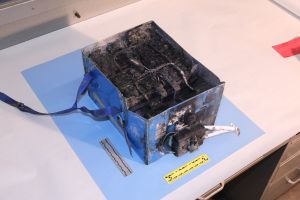We have all heard stories of the fire hazards that lithium-ion batteries present – just to remind you, here is a partial list:
There have been many other documented "thermal events". I personally have seen a lithium-ion battery catch fire on an engineer's bench and it was impressive.
One of the hazardous aspects of many lithium chemistries involves the flammability of their electrolyte (source):
Lithium-ion batteries can be dangerous under some conditions and can pose a safety hazard since they contain, unlike other rechargeable batteries, a flammable electrolyte and are also kept pressurized.
There are numerous discussions of the flammability of lithium-ion batteries on the web (example). While I understand how a lithium-ion battery can burn, I have never had a good understanding of how the fire can initiate.
Today, I saw this article and it gave a very good description of how a lithium-ion battery can be "encouraged" to catch fire. Here is the key quote:
A typical lithium-ion battery consists of two tightly packed electrodes – a carbon anode and a lithium metal-oxide cathode – with an ultrathin polymer separator in between. The separator keeps the electrodes apart. If it's damaged, the battery could short-circuit and ignite the flammable electrolyte solution that shuttles lithium ions back and forth.
"The separator is made of the same material used in plastic bottles," said graduate student Denys Zhuo, co-lead author of the study. "It's porous so that lithium ions can flow between the electrodes as the battery charges and discharges."
Manufacturing defects, such as particles of metal and dust, can pierce the separator and trigger shorting, as Sony discovered in 2006. Shorting can also occur if the battery is charged too fast or when the temperature is too low – a phenomenon known as overcharge.
"Overcharging causes lithium ions to get stuck on the anode and pile up, forming chains of lithium metal called dendrites," Cui explained. "The dendrites can penetrate the porous separator and eventually make contact with the cathode, causing the battery to short."
Dendrite formation causing trouble does not surprise me – I have had to deal with dendrites in other contexts (e.g. salt dendrites that formed across battery poles that were inadvertently exposed to sea water) and it is amazing how destructive they can be.
In case you are wondering why there is a separator in the battery, take a look in the Wikipedia under salt bridge.
Here is an FAA video on dealing with laptop battery fires that shows an actual laptop fire at LAX at the beginning of the video.


Pingback: I Must Be Old, All the Bugs Sound Familiar … | Math Encounters Blog